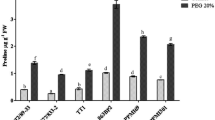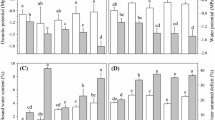Abstract
Water deficient or drought stress is a major factor causing deterioration or instability of malt barley quality. In the studies on the influence of drought stress during grain filling on malt quality formation or metabolic changes, it is quite difficult to obtain the uniform plant individuals and water condition in pot or field experiments. In this study, we combined barley spike in vitro culture and PEG-6000 simulated drought to determine the genotypic difference in the changes of grain metabolites and the expression level of the genes encoding β-amylase and β-glucan using two Tibetan wild barley accessions and two cultivated genotypes differing in malt quality stability under drought stress. Under simulated drought, grain weight and β-glucan content were dramatically reduced and β-amylase activity was increased, and a lot of metabolites were markedly changed for all genotypes. On the whole, the changes were relatively smaller in the wild barley. Meanwhile, the expressions of Bmy1 related to β-amylase synthesis and GSL1, GSL4 and GSL7 related to β-glucan synthesis were up-regulated and down-regulated under drought stress, respectively, being consistent with the changes of β-amylase activity and β-glucan content in the four barley genotypes. The current results showed that PEG-6000 simulated drought and spike in intro culture may provide the basically similar information on grain development or metabolites as do in the field experiments, and it is suitable for use in studies on the influence of drought stress on quality traits during grain filling stage of barley or other cereal crops.







Similar content being viewed by others
References
Ahmed IM, Cao F, Han Y, Nadira UA, Zhang G, Wu F (2013) Differential changes in grain ultrastructure, amylase, protein and amino acid profiles between Tibetan wild and cultivated barleys under drought and salinity alone and combined stress. Food Chem 141:2743–2750
Bamforth CW (1982) Barley β-glucans: their role in malting and brewing. Brewers Digest 3:22–35
Christensen U, Scheller HV (2012) Regulation of (1,3;1,4)-β-d-glucan synthesis in developing endosperm of barley lys mutants. J Cereal Sci 55:69–76
Gous PW, Gilbert RG, Fox GP (2015) Drought-proofing barley (Hordeum vulgare) and its impact on grain quality: a review. J Inst Brewing 121:19–27
Hejgaard J, Boisen S (1980) High-lysine proteins in Hiproly barley breeding: Identification, nutritional significance and new screening methods. Hereditas 93:311–320
Jacobsen KS, Kalvenes C, Olsen O-A (1991) mRNA levels in the developing aleurone and starchy endosperm in wild type and a high lysine (lys 3a) mutant of barley. Physiol Plant 83:201–208
Jones CA, Jacobsen JS, Wraith JM (2005) Response of malt barley to phosphorus fertilization under drought conditions. J Plant Nutr 28:1605–1617
Kaufmann MR, Eckard AN (1971) Evaluation of water stress control with polyethylene glycol by analysis of guttation. Plant Physiol 47:454–456
Lanzinger A, Frank T, Reichenberger G, Herz M, Engel K (2015) Metabolite profiling of barley grain subjected to induced drought stress: responses of free amino acids in differently adapted cultivars. J Agri Food Chem 63:4252–4261
Lisec J, Schauer N, Kopka J, Willmitzer L, Fernie AR (2006) Gas chromatography mass spectrometry–based metabolite profiling in plants. Nat Protoc 1:387–396
Luo JL, Tang SH, Peng XJ, Yan XH, Zeng XH, Li J, Li XF, Wu G (2015) Elucidation of cross-talk and specificity of early response mechanisms to salt and PEG-simulated drought stresses in brassica napus using comparative proteomic analysis. PLoS One 10:e0138974
Macnicol PK, Jacobsen JV, Keys MM, Stuart IM (1993) Effects of heat and water stress on malt quality and grain parameters of Schooner barley grown in cabinets. J Cereal Sci 18:61–68
McCleary BV, Codd R (1989) Measurement of β-amylase in cereal flours and commercial enzyme preparations. J Cereal Sci 9:17–33
McCleary BV, Codd R (1991) Measurement of (1/3), (1/4)-β-d-glucan in barley and oats: a streamlined enzymic procedure. J Sci Food Agr 55:303–312
Meng S, Zhang CX, Su L, Li YM, Zhao Z (2016) Nitrogen uptake and metabolism of Populus simonii in response to PEG-induced drought stress. Environ Exp Bot 123:78–87
Molina-Cano JL, Polo JP, Sopena A, Voltas J, Pérez-Vendrell AM, Romagosa I (2000) Mechanisms of malt extract development in barleys from different European regions II. Effect of barley hordein fractions on malt extract yield. J Inst Brew 106:117–123
Nam K, Kim D, Shin HJ, Nam KJ, An JH, Pack I, Park J, Jeong S, Kim HB, Kim C (2014) Drought stress-induced compositional changes in tolerant transgenic rice and its wild type. Food Chem 153:145–150
Neumann PM (2008) Coping mechanisms for crop plants in drought-prone environments. Ann Bot 101:901–907
Ovesná J, Kučera L, Vaculová K, Štrymplová K, Svobodová I, Milella L (2012) Validation of the β-amy1 transcription profiling assay and selection of reference genes suited for a RT-qPCR assay in developing barley caryopsis. PLoS One 7:e41886
Qi JC, Zhang GP, Zhou MX (2006) Protein and hordein content in barley seeds as affected by nitrogen level and their relationship to beta-amylase activity. J Cereal Sci 43:102–107
Raggi V (1992) Changes in water relations and in some physiological functions of bean under very light osmotic shock-induced by polyethylene-glycol. Physiol. Planta 84:537–548
Richards FJ (1959) A flexible growth function for empirical use. J Exp Bot 10:290–300
Romagosa I, Prada D, Moralejo MA, Sopena A, Munoz P, Casas AM, Swanston JS, Molina-Cano JL (2001) Dormancy, ABA content and sensitivity of a barley mutant to ABA application during seed development and after ripening. J Exp Bot 52:1499–1506
Savin R, Nicolas ME (1996) Effects of short periods of drought and high temperature on grain growth and starch accumulation of two malting barley cultivars. Funct Plant Biol 23:201–210
Schober MS, Burton RA, Shirley NJ, Jacob AK, Fincher GB (2009) Analysis of the (1,3)-β-d-glucan synthase gene family of barley. Phytochemistry 70:713–720
Sicher RC, Timlin D, Bailey B (2012) Responses of growth and primary metabolism of water-stressed barley roots to rehydration. J Plant Physiol 169:686–695
Sørensen MB, Cameron-Mils V, Brandt A (1989) Transcriptional and post-transcriptional regulation of gene expression in developing barley endo-sperm. Mol Gen Genet 217:195–201
Thameur A, Ferchichi A, López-Carbonell M (2014) Involvement of abscisic acid metabolites and the oxidative status of barley genotypes in response to drought. Cana J. Plant Sci 94:1481–1490
Wallwork MAB, Logue SJ, MacLeod LC, Jenner CE (1998) Effects of a period of high temperature during grain filling on the grain growth characteristics and malting quality of three Australian malting barleys. Aus J Agr Res 49:1287–1296
Wei K, Jin XL, Chen X, Wu FB, Zhou WH, Qiu BY, Qiu L, Wang XD, Li CD, Zhang GP (2009) The effect of H2O2 and abscisic acid (ABA) interaction on β-amylase activity under osmotic stress during grain development in barley. Plant Physiol Biochem 47:778–784
Wenzel A, Frank T, Reichenberger G, Herz M, Engel K (2015) Impact of induced drought stress on the metabolite profiles of barley grain. Metabolomics 11:454–467
Widodo PJH, Newbigin E, Tester M, Baci A, Roessner U (2009) Metabolic responses to salt stress of barley (Hordeum vulgare L.) cultivars, Sahara and Clipper, which differ in salinity tolerance. J Exp Bot 60:4089–4103
Wu D, Cai S, Chen M, Ye L, Chen Z, Zhang H, Dai F, Wu F, Zhang G (2013) Tissue metabolic responses to salt stress in wild and cultivated barley. PLoS One 8:e55431
Wu XJ, Chen X, Zeng FR, Zhang GP (2015) The genotypic difference in the effect of water stress after anthesis on the malt quality parameters in barley. J Cereal Sci 65:209–214
Yang JC, Zhang JH, Liu K, Wang ZQ, Liu LJ (2006) Abscisic acid and ethyleneinteract in wheat grains in response to soil drying during grain filling. New Phytol 171:293–303
Zekri M (1991) Effects of peg-induced water-stress on 2 citrus cultivars. J Plant Nutr 14:59–74
Zhang G, Chen J, Wang J, Ding S (2001) Cultivar and environmental effects on (1→3,1→4)-β-d-glucan and protein content in malting barley. J Cereal Sci 34:295–301
Acknowledgments
This research was supported by the National Natural Science Foundation of China (31330055, 31371559), the Fundamental Research Funds for the Central Universities (2014FZA6011) and Jiangsu Collaborative Innovation Center for Modern Crop Production (JCIC-MCP).
Author information
Authors and Affiliations
Corresponding author
Rights and permissions
About this article
Cite this article
Wu, X., Zeng, F. & Zhang, G. PEG-simulated drought stress and spike in vitro culture are used to study the impact of water stress on barley malt quality. Plant Growth Regul 81, 243–252 (2017). https://doi.org/10.1007/s10725-016-0201-z
Received:
Accepted:
Published:
Issue Date:
DOI: https://doi.org/10.1007/s10725-016-0201-z




